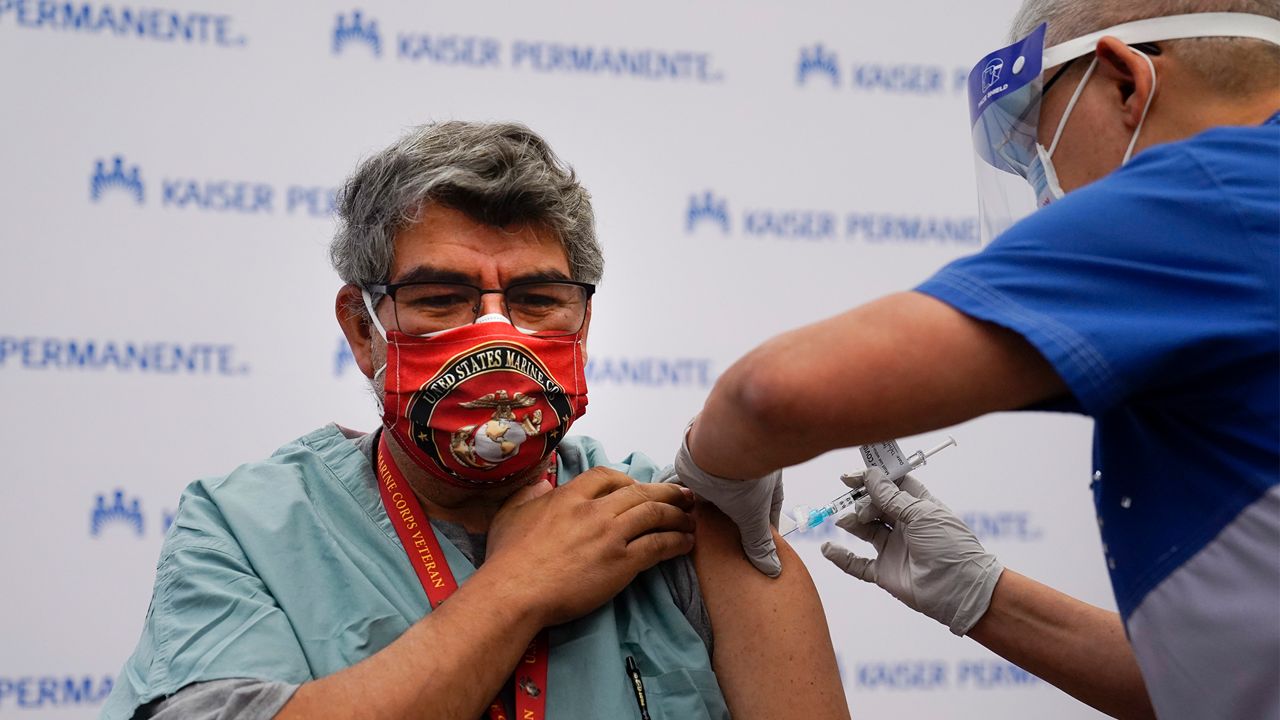LOS ANGELES (CNS) — COVID-19 vaccination efforts continued across the Southland Thursday, including the first wave of health care workers to be inoculated at Cedars-Sinai Medical Center, one of nine sites being used for ultra-cold storage of the Pfizer medication.
But while the vaccine continues to offer hope that an end to the pandemic is near, health officials continued warning that mass immunity is a long way off, and some questions still linger about the extent of the vaccination's effectiveness, and how long it actually offers protection against the virus.
Dr. Paul Simon, chief science officer for the county Department of Public Health, said that while the Pfizer and Moderna vaccines have both been shown to be effective in preventing symptomatic cases of COVID-19, it's still unsure "whether the vaccines prevent asymptomatic infection and further spread of the virus."
He also noted that people who receive the vaccine must continue taking all other precautions, such as mask wearing and physical distancing.
"It is true that persons can still become infected with the virus one to two weeks after the [vaccination] because it takes that long for the body to build up protections," Simon said.
But Simon also sought to dispel myths about the vaccination, noting that the medication does not contain any portion of the actual coronavirus, so people can't develop COVID-19 by being vaccinated. He also said nobody is being forced to get vaccinated, and insisted that despite the speed at which vaccines were developed, no safety protocols were suspended.
"Although the time frame has been condensed ... all of the normal steps in the vaccine-approval process have been maintained to ensure both vaccine safety and effectiveness," Simon said.
Health care workers remain at the top of the priority list for receiving the vaccine. At Cedars-Sinai, like most other hospitals, front-line workers in the emergency department and intensive-care unit were the first to be offered the vaccinations.
"Although this is a turning point in our fight against COVID-19, our staff will continue to employ other proven prevention methods such as wearing masks and gloves, maintaining physical distance from others, washing hands frequently and avoiding crowds," Dr. Richard V. Riggs, Cedars-Sinai's chief medical officer, said in a statement.
Shots were also being administered at various other medical centers Thursday, including the Martin Luther King Jr. Community Hospital in Willowbrook and Dignity Health Glendale Memorial Hospital.
The first vaccines in the county were administered Monday at Kaiser Permanante Los Angeles in Hollywood, with more medical centers following suit as the doses became available, including Ronald Reagan UCLA Medical Center on Wednesday.
The Los Angeles County Department of Health Services plans to begin its vaccination efforts Friday at three of the hospitals it operates — County- USC, Olive View-UCLA and Harbor-UCLA medical centers. The county says it plans to vaccinate 6,000 front-line workers at the hospitals by Christmas.
Los Angeles County received roughly 83,000 doses of the Pfizer vaccine, with the doses taken to the nine cold-storage sites for distribution to 83 acute-care hospitals across the county. Health care workers are atop the priority list for receiving the vaccine.
The vaccine, which received federal approval over the weekend for immediate use, is said to be 95% effective at preventing the virus.
Statewide, 327,600 doses of the Pfizer vaccine were expected to arrive this week, with another 393,900 doses from Pfizer next week, according to Gov. Gavin Newsom. Pending federal approval of Moderna's vaccination, the state is expected to receive 672,600 doses of that vaccine by the end of the month. The state hopes to receive as many as 2.16 million total doses by the end of the year, Gov. Gavin Newsom said.
A Food and Drug Administration advisory panel on Thursday recommended that the Moderna vaccine be approved for use — a key hurdle in its eventual approval for circulation.
Health-care workers and residents and staff of skilled nursing facilities and long-term care facilities are all included in what is known as Phase 1A of the vaccination-distribution program, meaning they will receive the first doses. Newsom said that group includes about 3 million people statewide.
Phase 1B of the program will be "essential workers," a category estimated to include 8 million people, Newsom said. Exact guidelines of what constitutes an "essential worker" and which ones will have the highest priority for vaccines have not been finalized.
Los Angeles County's initial allotment of Pfizer vaccine was expected to be 82,875 doses, a population-based percentage of the state allocation, according to county Public Health Director Barbara Ferrer.
Last week, Ferrer said the county hopes to receive its second allotment — roughly 250,000 doses of the Moderna vaccine, pending FDA approval — early next week. But she said Wednesday the timing and size of the county's next allotment of vaccine had not yet been finalized.
Much of the second dose allotment will be distributed directly skilled nursing facilities, allowing them to administer it right away instead of waiting for a federal distribution agreement with CVS and Walgreens to begin on roughly Dec. 28.
Long-term care facilities will still receive the vaccine through CVS and Walgreens.
The Moderna vaccine does not require the same ultra-cold storage as the Pfizer vaccine.
County officials said earlier they anticipate receiving another 150,000 doses of vaccine by the end of December, followed by weekly allotments of 250,000 beginning in January. The Moderna and Pfizer vaccines both require two doses, separated by about three weeks. With the county planning to vaccinate 6 million people in six months, that equates to 12 million doses of vaccine.
After the distribution of vaccines to health care workers, skilled nursing facilities and long-term care staff and residents is completed, followed by "essential workers," priority will then move to people at highest risk of severe illness from the virus, such as seniors or those with underlying health conditions.
Distribution to the general public will follow, but the timeline on when that will occur remains cloudy.



